Evaluating Multi-Criteria Decision-Making Methods for Sustainable Management of Forest Ecosystems: A Systematic Review
Abstract
:1. Introduction
2. Materials and Methods
2.1. Data Sources and Extraction
2.2. Description of Criteria for Inclusion and Exclusion
2.3. Data Analyses
3. Results
3.1. Overview of Selected Studies
3.1.1. Systematic Mapping and Selection of MCDM Model Applications in Forestry
3.1.2. Content Overview and Statistical Distribution of Selected Forest Management Studies
3.2. Analysis of MCDM Use over Time
3.3. Analysis of MCDM Use across Countries
3.4. Correlations between Models and Publication Journals
3.5. Indicators Used in MCDM Models
4. Discussion
4.1. Challenges or Disparities for MCDM Model Use in Sustainable Forest Management
4.2. Implications of MCDM Application in Forest Management Design under Climate Change
5. Conclusions and Research Needs
Supplementary Materials
Author Contributions
Funding
Data Availability Statement
Acknowledgments
Conflicts of Interest
References
- Farooq, M.S.; Uzair, M.; Raza, A.; Habib, M.; Xu, Y.; Yousuf, M.; Yang, S.H.; Ramzan Khan, M. Uncovering the research gaps to alleviate the negative impacts of climate change on food security: A review. Front. Plant Sci. 2022, 13, 927535. [Google Scholar] [CrossRef] [PubMed]
- Gomez-Zavaglia, A.; Mejuto, J.C.; Simal-Gandara, J. Mitigation of emerging implications of climate change on food production systems. Food Res. Int. 2020, 134, 109256. [Google Scholar] [CrossRef]
- Eder, A.; Salhofer, K.; Quddoos, A. The impact of cereal crop diversification on farm labor productivity under changing climatic conditions. Ecol. Econ. 2024, 223, 108241. [Google Scholar] [CrossRef]
- Alfani, F.; Molini, V.; Pallante, G.; Palma, A. Job displacement and reallocation failure. Evidence from climate shocks in Morocco. Eur. Rev. Agric. Econ. 2024, 51, 1–31. [Google Scholar] [CrossRef]
- PNUD. Adaptation au changement climatique pour les oasis résilientes. In Rapport D’étude sur L’évaluation du Changement Climatique Futur au Niveau des zones Oasiennes Marocaines; PNUD: Rabat, Maroc, 2011. [Google Scholar]
- Chakhchar, A.; Ben Salah, I.; El Kharrassi, Y.; Filali-Maltouf, A.; El Modafar, C.; Lamaoui, M. Agro-fruit-forest systems based on argan tree in Morocco: A review of recent results. Front. Plant Sci. 2022, 12, 783615. [Google Scholar] [CrossRef] [PubMed]
- Lamhamedi, M.; Bakry, M.; Sbay, H.; Hamrouni, L. Mise en application de nouvelles innovations techniques, technologiques et biotechnologiques pour la restauration, la domestication et l’intensification de la culture de l’arganier. In Proceedings of the 3rd Congrès International de L’arganier, Agadir, Maroc, 17–19 December 2015; pp. 215–226. [Google Scholar]
- Lamhamedi, M.S.; Abourouh, M.; Fortin, J.A. Technological transfer: The use of ectomycorrhizal fungi in conventional and modern forest tree nurseries in northern Africa. In Advances in Mycorrhizal Science and Technology; Khasa, D., Piché, Y., Coughlan, A.P., Eds.; NRC Research Press: Ottawa, ON, Canada, 2009; pp. 139–152. [Google Scholar]
- Zoubida, C.; Dom, G. Sustainable development in northern Africa: The argan forest case. Sustainability 2009, 1, 1012–1022. [Google Scholar] [CrossRef]
- Campos-Guzmán, V.; García-Cáscales, M.S.; Espinosa, N.; Urbina, A. Life cycle analysis with multi-criteria decision making: A review of approaches for the sustainability evaluation of renewable energy technologies. Renew. Sustain. Energy Rev. 2019, 104, 343–366. [Google Scholar] [CrossRef]
- Sitorus, F.; Brito-Parada, P.R. A multiple criteria decision making method to weight the sustainability criteria of renewable energy technologies under uncertainty. Renew. Sustain. Energy Rev. 2020, 127, 109891. [Google Scholar] [CrossRef]
- Navarro, I.J.; Penadés-Plà, V.; Martínez-Muñoz, D.; Rempling, R.; Yepes, V. Life cycle sustainability assessment for multi-criteria decision making in bridge design: A review. J. Civ. Eng. Manag. 2020, 26, 690–704. [Google Scholar] [CrossRef]
- Ananda, J.; Herath, G. A critical review of multi-criteria decision making methods with special reference to forest management and planning. Ecol. Econ. 2009, 68, 2535–2548. [Google Scholar] [CrossRef]
- Kozłowski, K.; Pietrzykowski, M.; Czekała, W.; Dach, J.; Kowalczyk-Juśko, A.; Jóźwiakowski, K.; Brzoski, M. Energetic and economic analysis of biogas plant with using the dairy industry waste. Energy 2019, 183, 1023–1031. [Google Scholar] [CrossRef]
- Petrillo, A.; De Felice, F.; Jannelli, E.; Autorino, C.; Minutillo, M.; Lavadera, A.L. Life cycle assessment (LCA) and life cycle cost (LCC) analysis model for a stand-alone hybrid renewable energy system. Renew. Energy 2016, 95, 337–355. [Google Scholar] [CrossRef]
- Naggar, M.; Mhirit, O. L’arganeraie: Un parcours typique des zones arides et semi-arides marocaines. Sci. Chang. Planétaires/Sécheresse 2006, 17, 314–317. [Google Scholar]
- Benzyane, M.; Naggar, M.; Lahlou, B. L’aménagement des forêts sud-méditerranéennes: Quelle approche? Forêt Méditerranéenne 2002, 23, 201–210. [Google Scholar]
- Belton, V.; Stewart, T.J. Multiple Criteria Decision Analysis: An Integrated Approach; Kluwer Academic Publishers: Boston, MA, USA, 2002. [Google Scholar]
- Abdel-Basset, M.; Gamal, A.; Chakrabortty, R.K.; Ryan, M. Development of a hybrid multi-criteria decision-making approach for sustainability evaluation of bioenergy production technologies: A case study. J. Clean. Prod. 2021, 290, 125805. [Google Scholar] [CrossRef]
- Torkayesh, A.E.; Rajaeifar, M.A.; Rostom, M.; Malmir, B.; Yazdani, M.; Suh, S.; Heidrich, O. Integrating life cycle assessment and multi criteria decision making for sustainable waste management: Key issues and recommendations for future studies. Renew. Sustain. Energy Rev. 2022, 168, 112819. [Google Scholar] [CrossRef]
- Kaymaz, Ç.K.; Birinci, S.; Kızılkan, Y. Sustainable development goals assessment of Erzurum Province with SWOT-AHP analysis. Environ. Dev. Sustain. 2022, 24, 2986–3012. [Google Scholar] [CrossRef]
- Sahabuddin, M.; Khan, I. Multi-criteria decision analysis methods for energy sector’s sustainability assessment: Robustness analysis through criteria weight change. Sustain. Energy Technol. Assess. 2021, 47, 101380. [Google Scholar] [CrossRef]
- Figueira, J.; Greco, S.; Ehrgott, M. Multiple Criteria Decision Analysis: State of the Art Surveys, 2nd ed.; Springer: New York, NY, USA, 2005. [Google Scholar]
- Blagojević, B.; Jonsson, R.; Björheden, R.; Nordström, E.-M.; Lindroos, O. Multi-criteria decision analysis (MCDA) in forest operations—An introductional review. Croat. J. For. Eng. 2019, 40, 191–2015. [Google Scholar]
- Raju, K.S.; Pillai, C. Multicriterion decision making in performance evaluation of an irrigation system. Eur. J. Oper. Res. 1999, 112, 479–488. [Google Scholar] [CrossRef]
- D’Adamo, I. The analytic hierarchy process as an innovative way to enable stakeholder engagement for sustainability reporting in the food industry. Environ. Dev. Sustain. 2023, 25, 15025–15042. [Google Scholar] [CrossRef]
- Mena, S.B. Introduction aux méthodes multicritères d’aide à la décision. Biotechnol. Agron. Soc. Environ. 2000, 4, 83–93. [Google Scholar]
- Bergez, J.E.; Béthinger, A.; Bockstaller, C.; Cederberg, C.; Ceschia, E.; Guilpart, N.; Lange, S.; Müller, F.; Reidsma, P.; Riviere, C.; et al. Integrating agri-environmental indicators, ecosystem services assessment, life cycle assessment and yield gap analysis to assess the environmental sustainability of agriculture. Ecol. Indic. 2022, 141, 109107. [Google Scholar] [CrossRef]
- Castoldi, N.; Bechini, L. Integrated sustainability assessment of cropping systems with agro-ecological and economic indicators in northern Italy. Eur. J. Agron. 2010, 32, 59–72. [Google Scholar] [CrossRef]
- Dabkiene, V.; Balezentis, T.; Streimikiene, D. Development of agri-environmental footprint indicator using the FADN data: Tracking development of sustainable agricultural development in Eastern Europe. Sustain. Prod. Consum. 2021, 27, 2121–2133. [Google Scholar] [CrossRef]
- Latruffe, L.; Diazabakana, A.; Bockstaller, C.; Desjeux, Y.; Finn, J.; Kelly, E.; Ryan, M.; Uthes, S. Measurement of sustainability in agriculture: A review of indicators. Stud. Agric. Econ. 2016, 118, 123–130. [Google Scholar] [CrossRef]
- Robling, H.; Abu Hatab, A.; Säll, S.; Hansson, H. Measuring sustainability at farm level—A critical view on data and indicators. Environ. Sustain. Indic. 2023, 18, 100258. [Google Scholar] [CrossRef]
- Sulewski, P.; Kłoczko-Gajewska, A. Development of the sustainability index of farms based on surveys and FADN sample. Probl. Agric. Econ. 2018, 3, 32–56. [Google Scholar] [CrossRef]
- Zahm, F.; Ugaglia, A.A.; De l’Homme, B. L’évaluation de la performance globale d’une exploitation agricole. Synthèse des cadres conceptuels, des outils de mesure et application avec la méthode IDEA. In Proceedings of the 8th Congrès du RIODD, Lille, France, 8 June 2013; p. 32. [Google Scholar]
- Aleisa, E.; Al-Jarallah, R. A triple bottom line evaluation of solid waste management strategies: A case study for an arid Gulf State, Kuwait. Int. J. Life Cycle Assess. 2018, 23, 1460–1475. [Google Scholar] [CrossRef]
- Eggers, J.; Holmgren, S.; Nordström, E.-M.; Lämås, T.; Lind, T.; Öhman, K. Balancing different forest values: Evaluation of forest management scenarios in a multi-criteria decision analysis framework. For. Policy Econ. 2019, 103, 55–69. [Google Scholar] [CrossRef]
- Sari, F. Forest fire susceptibility mapping via multi-criteria decision analysis techniques for Mugla, Turkey: A comparative analysis of VIKOR and TOPSIS. For. Ecol. Manag. 2021, 480, 118644. [Google Scholar] [CrossRef]
- Saaty, T.L. The analytic hierarchy process—What it is and how it is used. Math. Model. 1987, 9, 161–176. [Google Scholar] [CrossRef]
- Soam, S.K.; Srinivasa Rao, N.; Yashavanth, B.S.; Balasani, R.; Rakesh, S.; Marwaha, S.; Kumar, P.; Agrawal, R. AHP analyser: A decision-making tool for prioritizing climate change mitigation options and forest management. Front. Environ. Sci. 2023, 10, 1099996. [Google Scholar] [CrossRef]
- Rezaeinia, N. Eigenvalue-utilité additive approach for evaluating multi-criteria decision-making problem. J. Multi-Criteria Decis. Anal. 2022, 29, 431–445. [Google Scholar] [CrossRef]
- Tahri, M.; Kaspar, J.; Vacik, H.; Marusak, R. Multi-attribute decision making and geographic information systems: Potential tools for evaluating forest ecosystem services. Ann. For. Sci. 2021, 78, 41. [Google Scholar] [CrossRef]
- Taherdoost, H.; Madanchian, M. Multi-criteria decision making (MCDM) methods and concepts. Encyclopedia 2023, 3, 77–87. [Google Scholar] [CrossRef]
- Zanndouche, O.; Derridj, A.; Belhadj-Aissa, M.; Borovics, A.; Somogyi, N.; Abla, S.; Larbi, M.Y.; Hamdache, A.; Kahouadji, N. Contribution of GIS in the identification and mapping of natural forest habitats: Case study of the forests of El Kala, Wilaya of El Tarf, Algeria. Indian J. Ecol. 2022, 49, 682–688. [Google Scholar] [CrossRef]
- Stefanoni, W.; Tocci, D.; Latterini, F.; Venanzi, R.; Gaglioppa, P.; Pari, L.; Picchio, R. A preliminary validation and assessment of a GIS approach related to precision forest harvesting in Central Italy. Forests 2023, 14, 127. [Google Scholar] [CrossRef]
- Slimani, M.A.; Aboudi, A.E.; Rahimi, A.; Khalil, Z. Use of GIS and satellite imagery in the study of the spatial distribution of vegetation in the Entifa forest (High Atlas Central, Morocco). In Proceedings of the Euro-Mediterranean Conference for Environmental Integration (EMCEI-1), Sousse, Tunisia, 1–4 November 2022; pp. 1749–1751. [Google Scholar]
- Seddouki, M.; Benayad, M.; Aamir, Z.; Tahiri, M.; Maanan, M.; Rhinane, H. Using machine learning coupled with remote sensing for forest fire susceptibility mapping. Case study Tetouan Province, Northern Morocco. ISPRS Arch. 2023, 48, 333–342. [Google Scholar] [CrossRef]
- Samari, D.; Azadi, H.; Zarafshani, K.; Hosseininia, G.; Witlox, F. Determining appropriate forestry extension model: Application of AHP in the Zagros area, Iran. For. Policy Econ. 2012, 15, 91–97. [Google Scholar] [CrossRef]
- Berrang-Ford, L.; Pearce, T.; Ford, J.D. Systematic review approaches for climate change adaptation research. Reg. Environ. Chang. 2015, 15, 755–769. [Google Scholar] [CrossRef]
- Ishtiaque, A. US farmers’ adaptations to climate change: A systematic review of the adaptation-focused studies in the US agriculture context. Environ. Res. Clim. 2023, 2, 022001. [Google Scholar] [CrossRef]
- Epule Epule, T.; Ford, J.D.; Lwasa, S.; Lepage, L. Climate change adaptation in the Sahel. Environ. Sci. Policy 2017, 75, 121–137. [Google Scholar] [CrossRef]
- Delgado López-Cózar, E.; Orduña-Malea, E.; Martín-Martín, A. Google Scholar as a data source for researchassessment. In Springer Handbook of Science and Technology Indicators; Glänzel, W., Moed, H.F., Schmoch, U., Thelwall, M., Eds.; Springer Handbooks: Cham, Switzerland, 2019. [Google Scholar] [CrossRef]
- Singh, V.K.; Srichandan, S.S.; Piryani, R.; Kanaujia, A.; Bhattacharya, S. Google Scholar as a pointer to open full-text sources of research articles: A useful tool for researchers in regions with poor access to scientific literature. J. Sci. Technol. Innov. Dev. 2023, 15, 450–457. [Google Scholar] [CrossRef]
- Gusenbauer, M. Search where you will find most: Comparing the disciplinary coverage of 56 bibliographic databases. Scientometrics 2022, 127, 2683–2745. [Google Scholar] [CrossRef]
- Delgado-Quirós, L.; Ortega, J.L. Completeness degree of publication metadata in eight free-access scholarly databases. Quant. Sci. Stud. 2024, 5, 31–49. [Google Scholar] [CrossRef]
- Bloch, L.; Rückert, J.; Friedrich, C.M. PreprintResolver: Improving citation quality by resolving published versions of ArXiv preprints using literature databases. In Proceedings of the International Conference on Theory and Practice of Digital Libraries, Zadar, Croatia, 26–29 September 2023; pp. 47–61. [Google Scholar]
- Ortega, J.L.; Quirós, L.J.D. Retractions, retracted articles and withdrawals coverage in scholarly databases. In Proceedings of the 27th International Conference on Science, Technology and Innovation Indicators (STI 2023), Leiden, The Netherlands, 27–29 September 2023. [Google Scholar]
- Tay, A. Digital tools-Supporting systematic reviews & evidence synthesis. Where are we now and what might the future look like? In Proceedings of the ALIA HLA Lunchtime Seminar 2023, Singapore, 12 August 2022; pp. 1–39. [Google Scholar]
- Rosenstock, T.S.; Lamanna, C.; Chesterman, S.; Bell, P.; Arslan, A.; Richards, M.B.; Rioux, J.; Akinleye, A.; Champalle, C.; Cheng, Z. The scientific basis of climate-smart agriculture: A systematic review protocol. In CCAFS Working Paper; CGIAR Research Program on Climate Change, Agriculture and Food Security (CCAFS): Palmira, Colombia, 2016. [Google Scholar]
- Rahman, M.M.; Szabó, G. Sustainable urban land-use optimization using GIS-based multicriteria decision-making (GIS-MCDM) approach. ISPRS Int. J. Geo-Information 2022, 11, 313. [Google Scholar] [CrossRef]
- Joppa, L.N.; McInerny, G.; Harper, R.; Salido, L.; Takeda, K.; O’Hara, K.; Gavaghan, D.; Emmott, S. Troubling trends in scientific software use. Science 2013, 340, 814–815. [Google Scholar] [CrossRef] [PubMed]
- Bhatia, M.; Williams, A. Selection of criteria using MCDM techniques—An application in renewable energy. arXiv 2023, arXiv:2303.17520. [Google Scholar]
- Bertini, A.; Caruso, I.; Vitolo, T. Methods and scenario analysis into regional area participatory planning of sustainable development: The “Roses Valley” in Southern Morocco, a case study. Eng. Proc. 2023, 39, 8. [Google Scholar] [CrossRef]
- Berezka, K.; Kovalchuk, O. Correspondence analysis as a tool for computer modeling of sustainable development. Econom. J. 2018, 22, 9–23. [Google Scholar] [CrossRef]
- El Kadiri, K.; El Kadiri, K.; Chalouan, A.; Bahmad, A.; Salhi, F.; Liemlahi, H. Factorial correspondence analysis: A useful tool in palaeogeographical reconstructions; example from late Cretaceous calciturbidites of the northwestern External Rif (Morocco). Geol. Soc. Spec. Publ. 2006, 262, 147–160. [Google Scholar] [CrossRef]
- Ortiz-Urbina, E.; Diaz-Balteiro, L.; PARDOS, M.; Gonzalez-Pachon, J. Representative Group Decision-Making in Forest Management: A Compromise Approach; Elsevier BV: Amsterdam, The Netherlands, 2022. [Google Scholar]
- Triantaphyllou, E. Multi-criteria decision making methods. In Multi-Criteria Decision Making Methods: A Comparative Study; Springer: Boston, MA, USA, 2000. [Google Scholar]
- Lacaze, B.; Peltier, J.; Aboudi, A.; Msanda, F.; Smiej, M.; Adil, M.; Gana, A.; El Amrani, M. Etude intégrée du milieu naturel et humain de l’arganeraie pour une aide à la décision en matière de préservation et de développement durable. Ann. Rech. For. Maroc 2007, 38, 1–12. [Google Scholar]
- McHenry, M.P.; Kulshreshtha, S.; Lac, S. Land Use, Land-Use Change and Forestry; Nova Science Publishers: Hauppauge, NY, USA, 2015; pp. 1–160. [Google Scholar]
- Baynes, J.; Herbohn, J.; Smith, C.; Fisher, R.; Bray, D. Key factors which influence the success of community forestry in developing countries. Glob. Environ. Chang. 2015, 35, 226–238. [Google Scholar] [CrossRef]
- Benchekroun, F.; Buttoud, G. L’arganeraie dans l’économie rurale du sud-ouest marocain. For. Médit. 1989, 11, 127–136. [Google Scholar]
- Sinsin, T.E.; Mounir, F.; El Aboudi, A. Comparative analysis of spatio-temporal dynamics in the plain and mountain argan ecosystems, Morocco. Int. J. Environ. Stud. 2020, 77, 565–580. [Google Scholar] [CrossRef]
- Moukrim, S.; Lahssini, S.; Rhazi, M.; Alaoui, H.M.; Benabou, A.; Wahby, I.; El Madihi, M.; Arahou, M.; Rhazi, L. Climate change impacts on potential distribution of multipurpose agro-forestry species: Argania spinosa (L.) Skeels as case study. Agrofor. Syst. 2019, 93, 1209–1219. [Google Scholar] [CrossRef]
- Sahoo, S.K.; Goswami, S.S. A comprehensive review of multiple criteria decision-making (MCDM) methods: Advancements, applications, and future directions. Decis. Mak. Adv. 2023, 1, 25–48. [Google Scholar] [CrossRef]
- Pagone, E.; Salonitis, K. Comparative study of multi-criteria decision analysis methods in environmental sustainability. In Proceedings of the International Conference on Sustainable Design and Manufacturing, Singapore, 14–16 September 2022; pp. 223–231. [Google Scholar]
- Castella, J.-C.; Lestrelin, G. Explorer l’impact environnemental des transformations agraires en Asie du Sud-Est grâce à l’évaluation participative des services écosystémiques. Cah. Agric. 2021, 30, 11. [Google Scholar] [CrossRef]
- Riandari, F.; Albert, M.Z.; Rogoff, S.S. MCDM methods to address sustainability challenges, such as climate change, resource management, and social justice. Ideaf. Res. 2023, 1, 25–38. [Google Scholar] [CrossRef]
- Deng, D.; Ye, C.; Tong, K.; Zhang, J. Evaluation of the sustainable forest management performance in forestry enterprises based on a hybrid multi-criteria decision-making model: A case study in China. Forests 2023, 14, 2267. [Google Scholar] [CrossRef]
- Ezquerro, M.; Pardos, M.; Diaz-Balteiro, L. Sustainability in forest management revisited using multi-criteria decision-making techniques. Sustainability 2019, 11, 3645. [Google Scholar] [CrossRef]
- Singh, B.K.; Delgado-Baquerizo, M.; Egidi, E.; Guirado, E.; Leach, J.E.; Liu, H.; Trivedi, P. Climate change impacts on plant pathogens, food security and paths forward. Nat. Rev. Microbiol. 2023, 21, 640–656. [Google Scholar] [CrossRef]
- Ifaadassan, I.; Karmaoui, A.; Messouli, M.; Ougougdal, H.A.; Yacoubi, M.K.; Babqiqi, A. Impact of Thermal Stress on the Moroccan Argan Agroecosystem. In Impacts of Climate Change on Agriculture and Aquaculture; IGI Global: Hershey, PA, USA, 2021; pp. 108–117. [Google Scholar]
- Long, C.H.B.; Quynh, P.H.N.; Tram, P.H.; Chi, H.T.X. Analysis of Priority Decision Rules Using MCDM Approach for a Dual-Resource Constrained Flexible Job Shop Scheduling by Simulation Method; IEOM Society International: Southfield, MI, USA, 2023. [Google Scholar]
- Yamada, Y.; Yamaura, Y. Decision support system for adaptive regional-scale forest management by multiple decision-makers. Forests 2017, 8, 453. [Google Scholar] [CrossRef]
- Wolfslehner, B.; Vacik, H. Mapping indicator models: From intuitive problem structuring to quantified decision-making in sustainable forest management. Ecol. Indic. 2011, 11, 274–283. [Google Scholar] [CrossRef]
- Xiao, S.; Zhan, C.; Wang, M.; Sun, Q.; Zhang, Y. Optimization strategy of national park resource utilization system—Take Bawangling Zone of Hainan Tropical Rain Forest National Park as an example. Sustain. For. 2022, 4, 14–28. [Google Scholar] [CrossRef]
- Vaghela, B.N.; Parmar, M.G.; Solanki, H.A.; Kansara, B.B.; Prajapati, S.K.; Kalubarme, M.H. Multi criteria decision making (MCDM) approach for mangrove health assessment using geo-informatics technology. Int. J. Environ. Geoinf. 2018, 5, 114–131. [Google Scholar] [CrossRef]
- Tüdeş, Ş.; Kumlu, K.B.Y. Solid Waste Landfill Site Selection in the Sense of Environment Sensitive Sustainable Urbanization: Izmir, Turkey Case; IOP Publishing: Bristol, UK, 2017; Volume 245. [Google Scholar]
- Tsiaras, S.; Papathanasiou, J. Decision making under the scope of forest policy: Sustainable agroforestry systems in less favoured areas. Int. J. Sustain. Agric. Manag. Inform. 2018, 4, 205. [Google Scholar] [CrossRef]
- Tanim, A.H.; Goharian, E.; Moradkhani, H. Integrated socio-environmental vulnerability assessment of coastal hazards using data-driven and multi-criteria analysis approaches. Sci. Rep. 2022, 12, 11625. [Google Scholar] [CrossRef] [PubMed]
- Shang, Z.; He, H.S.; Xi, W.; Shifley, S.R.; Palik, B.J. Integrating LANDIS model and a multi-criteria decision-making approach to evaluate cumulative effects of forest management in the Missouri Ozarks, USA. Ecol. Model. 2012, 229, 50–63. [Google Scholar] [CrossRef]
- Schaduw, J.N.W. Management strategy mangrove ecosystem base on multy criteria decision making analysis (case in Bunaken Island, Manado City, Indonesia). J. Ilm. PLATAX 2020, 8, 77–88. [Google Scholar] [CrossRef]
- Sahraei, R.; Ghorbanian, A.; Kanani-Sadat, Y.; Jamali, S.; Homayouni, S. Mangrove plantation suitability mapping by integrating multi criteria decision making geospatial approach and remote sensing data. Geo-Spat. Inf. Sci. 2023, 27, 1290–1308. [Google Scholar] [CrossRef]
- Reza, M.I.H.; Abdullah, S.A.; Nor, S.B.M.; Ismail, M.H. Integrating GIS and expert judgment in a multi-criteria analysis to map and develop a habitat suitability index: A case study of large mammals on the Malayan Peninsula. Ecol. Indic. 2013, 34, 149–158. [Google Scholar] [CrossRef]
- Reinhardt, J.R.; Russell, M.B.; Lazarus, W.F. Prioritizing invasive forest plant management using multi-criteria decision analysis in Minnesota, USA. Forests 2020, 11, 1213. [Google Scholar] [CrossRef]
- Ngo, D.T.; Sakai, T. Institutions and performance of community forest management: Multi-criteria analysis framework in a case of forest management in Central Vietnam. J. For. Plan. 2011, 16, 301–308. [Google Scholar] [CrossRef]
- Naskar, S.; Rahaman, A.; Biswas, B. Forest Fire Susceptibility Mapping of West Sikkim District, India using MCDA techniques of AHP & TOPSIS model. Res. Sq. 2022, 1–23. [Google Scholar] [CrossRef]
- Merganič, J.; Merganičová, K.; Výbošťok, J.; Valent, P.; Bahýľ, J. Impact of Interest Rates on Forest Management Planning Based on Multi-Criteria Decision Analysis; Walter de Gruyter GmbH: Berlin, Germany, 2022; Volume 68, pp. 23–35. [Google Scholar]
- Martínez, J.M.G.; de Castro-Pardo, M.; Rodríguez, F.P.; Martín, J.M.M. Innovation and multi-level knowledge transfer using a multi-criteria decision making method for the planning of protected areas. J. Innov. Knowl. 2019, 4, 256–261. [Google Scholar] [CrossRef]
- Marqués, A.I.; García, V.; Sánchez, J.S. Ranking-based MCDM models in financial management applications: Analysis and emerging challenges. Prog. Artif. Intell. 2020, 9, 171–193. [Google Scholar] [CrossRef]
- Kucukarslan, A.B.; Koksal, M.; Ekmekci, I. A model proposal for measuring performance in occupational health and safety in forest fires. Sustainability 2023, 15, 14729. [Google Scholar] [CrossRef]
- Khosravi, K.; Shahabi, H.; Binh Thai, P.; Adamowski, J.; Shirzadi, A.; Pradhan, B.; Dou, J.; Ly, H.-B.; Grof, G.; Huu Loc, H.; et al. A comparative assessment of flood susceptibility modeling using multi-criteria decision-making analysis and machine learning methods. J. Hydrol. 2019, 573, 311–323. [Google Scholar] [CrossRef]
- Khorrami, B.; Kamran, K.V. A fuzzy multi-criteria decision-making approach for the assessment of forest health applying hyper spectral imageries: A case study from Ramsar forest, North of Iran. Int. J. Eng. Geosci. 2022, 214–220. [Google Scholar] [CrossRef]
- Jalilova, G.; Khadka, C.; Vacik, H. Utilizing multiple criteria and decision analysis for sustainable walnut fruit forests management of kyrgyzstan. ISAHP Proc. 2011, 7, 2013. [Google Scholar] [CrossRef]
- Malekmohammadi, B.; Jahanishakib, F. Vulnerability assessment of wetland landscape ecosystem services using driver-pressure-state-impact-response (DPSIR) model. Ecol. Indic. 2017, 82, 293–303. [Google Scholar] [CrossRef]
- Jahani, A.; Feghhi, J.; Makhdoum, M.F.; Omid, M. Optimized forest degradation model (OFDM): An environmental decision support system for environmental impact assessment using an artificial neural network. J. Environ. Plan. Manag. 2015, 59, 222–244. [Google Scholar] [CrossRef]
- Hayati, E.; Majnounian, B.; Abdi, E.; Sessions, J.; Makhdoum, M. An Expert-Based Approach to Forest Road Network Planning by Combining Delphi and Spatial Multi-Criteria Evaluation; Springer Science+Business Media: Berlin/Heidelberg, Germany, 2012; Volume 185, pp. 1767–1776. [Google Scholar]
- Hajizadeh, H.; Fallah, A.; Hosseini, S. Evaluation of forest ecosystem functions using integrated methods of multi-criteria decision making (case study: Mazandaran Provence, Shiadeh and Diva Forest Ecosystem). J. Res. Ecol. For. 2022, 10, 33–42. [Google Scholar] [CrossRef]
- Gourabi, B.R.; Rad, T.G. The analysis of ecotourism potential in Boujagh wetland with AHP method. J. Stud. Hum. Settl. Plan. 2013, 8, 29–40. [Google Scholar]
- Ghorbanzadeh, O.; Blaschke, T.; Gholamnia, K.; Aryal, J. Forest fire susceptibility and risk mapping using social/infrastructural vulnerability and environmental variables. Fire 2019, 2, 50. [Google Scholar] [CrossRef]
- Feng, J.; Wang, J.; Shuaichen, Y.; Lubin, D. Dynamic Assessment of Forest Resources Quality at the Provincial Level Using AHP and Cluster Analysis; Elsevier BV: Amsterdam, The Netherlands, 2016; Volume 124, pp. 184–193. [Google Scholar]
- Ezquerro, M.; Diaz-Balteiro, L.; Pardos, M. Implications of forest management on the conservation of protected areas: A new proposal in Central Spain. For. Ecol. Manag. 2023, 548, 21428. [Google Scholar] [CrossRef]
- Eyvindson, K.; Kurttila, M.; Hujala, T.; Salminen, O. An internet-supported planning approach for joint ownership forest holdings. Small Scale For. 2011, 10, 1–17. [Google Scholar] [CrossRef]
- Etemad, S.; Limaei, S.M.; Olsson, L.; Yousefpour, R. Decision Making on Sustainable Forest Harvest Production Using Goal Programming Approach (Case Study: Iranian Hyrcanian Forest); IEEE: New York, NY, USA, 2018. [Google Scholar]
- Estrella, R.; Cattrysse, D.; Orshoven, J.V. Comparison of three ideal point-based multi-criteria decision methods for afforestation planning. Forests 2014, 5, 3222–3240. [Google Scholar] [CrossRef]
- Drăgoi, M.; Palaghianu, C.; Miron-Onciul, M. Benefit, cost and risk analysis on extending the forest roads network: A case study in Crasna Valley (Romania). Ann. For. Res. 2015, 58, 333–345. [Google Scholar] [CrossRef]
- de Sousa Xavier, A.M.; de Belem Costa Freitas, M.; de Sousa Fragoso, R.M. Management of Mediterranean forests—A compromise programming approach considering different stakeholders and different objectives. For. Policy Econ. 2015, 57, 38–46. [Google Scholar] [CrossRef]
- Chiteculo, V.; Abdollahnejad, A.; Panagiotidis, D.; Surovy, P. Effects, Monitoring and Management of Forest Roads Using Remote Sensing and GIS in Angolan Miombo Woodlands. Forests 2022, 13, 524. [Google Scholar] [CrossRef]
- Chakraborty, S.; Sahoo, S.; Majumdar, D.; Saha, S.; Roy, S. Future mangrove suitability assessment of Andaman to strengthen sustainable development. J. Clean. Prod. 2019, 234, 597–614. [Google Scholar] [CrossRef]
- Cammerino, A.R.B.; Ingaramo, M.; Piacquadio, L.; Monteleone, M. Assessing and mapping forest functions through a GIS-based, multi-criteria approach as a participative planning tool: An application analysis. Forests 2023, 14, 934. [Google Scholar] [CrossRef]
- Çalışkan, E. Planning of environmentally sound forest road route using GIS & S-MCDM. Sumar. List. 2017, 141, 591. [Google Scholar] [CrossRef]
- Caglayan, İ.; Yeşil, A.; Cieszewski, C.; Gül, F.K.; Kabak, Ö. Mapping of recreation suitability in the Belgrad Forest Stands. Appl. Geogr. 2020, 116, 102153. [Google Scholar] [CrossRef]
- Buğday, E.; Akay, A.E. Evaluation of forest road network planning in landslide sensitive areas by GIS-based multi-criteria decision making approaches in Ihsangazi watershed, Northern Turkey. Sumar. List. 2019, 143, 336. [Google Scholar] [CrossRef]
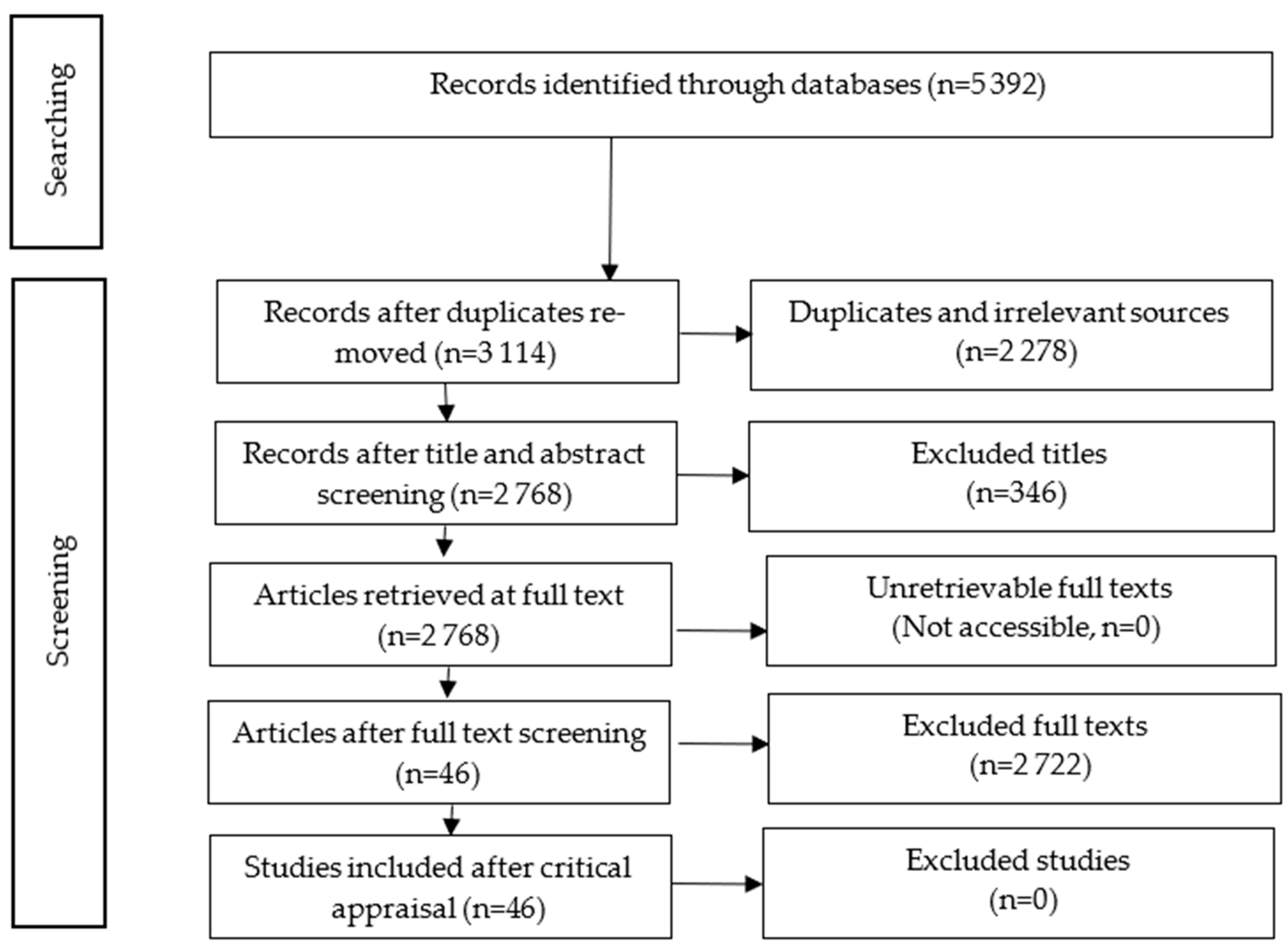


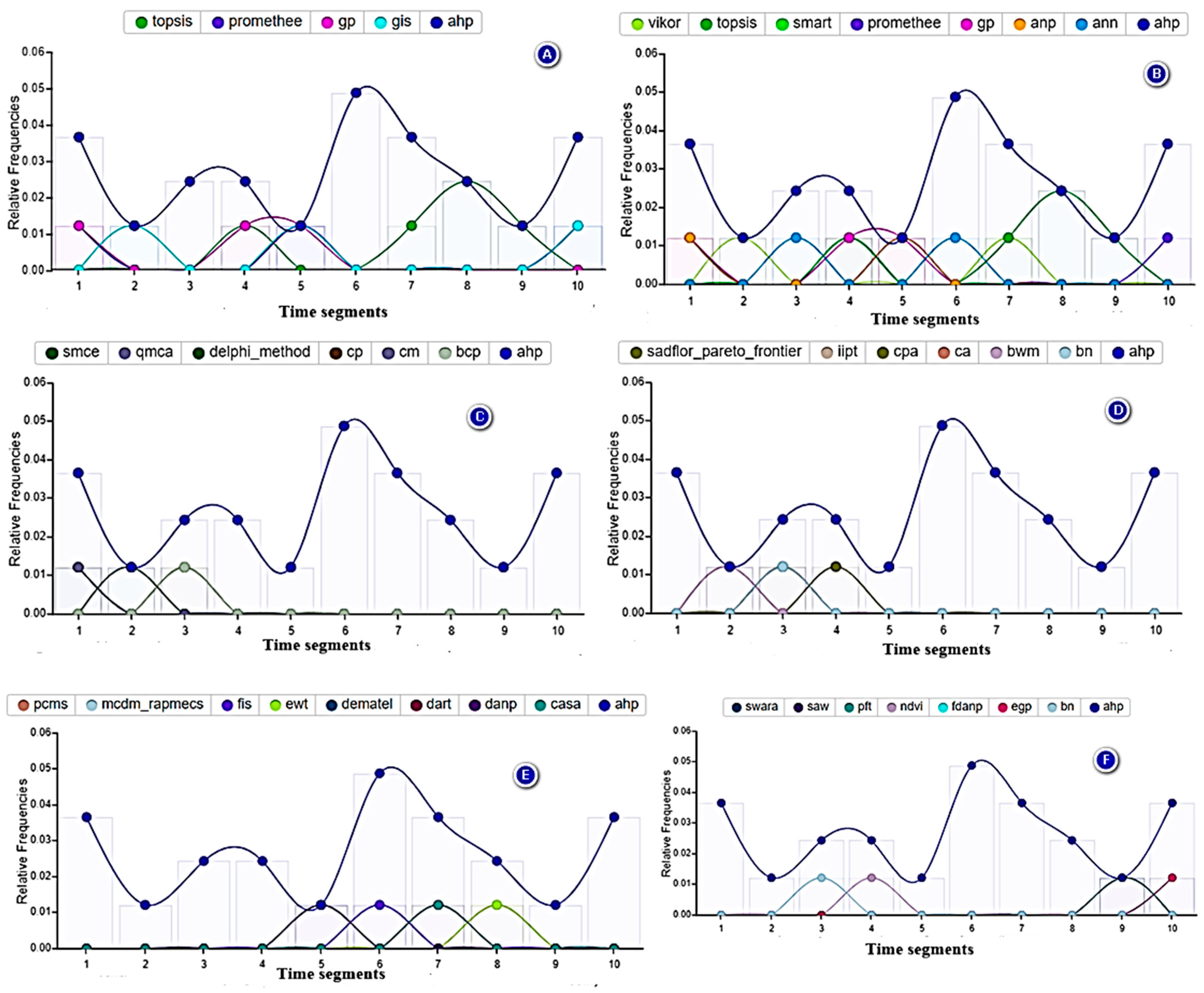
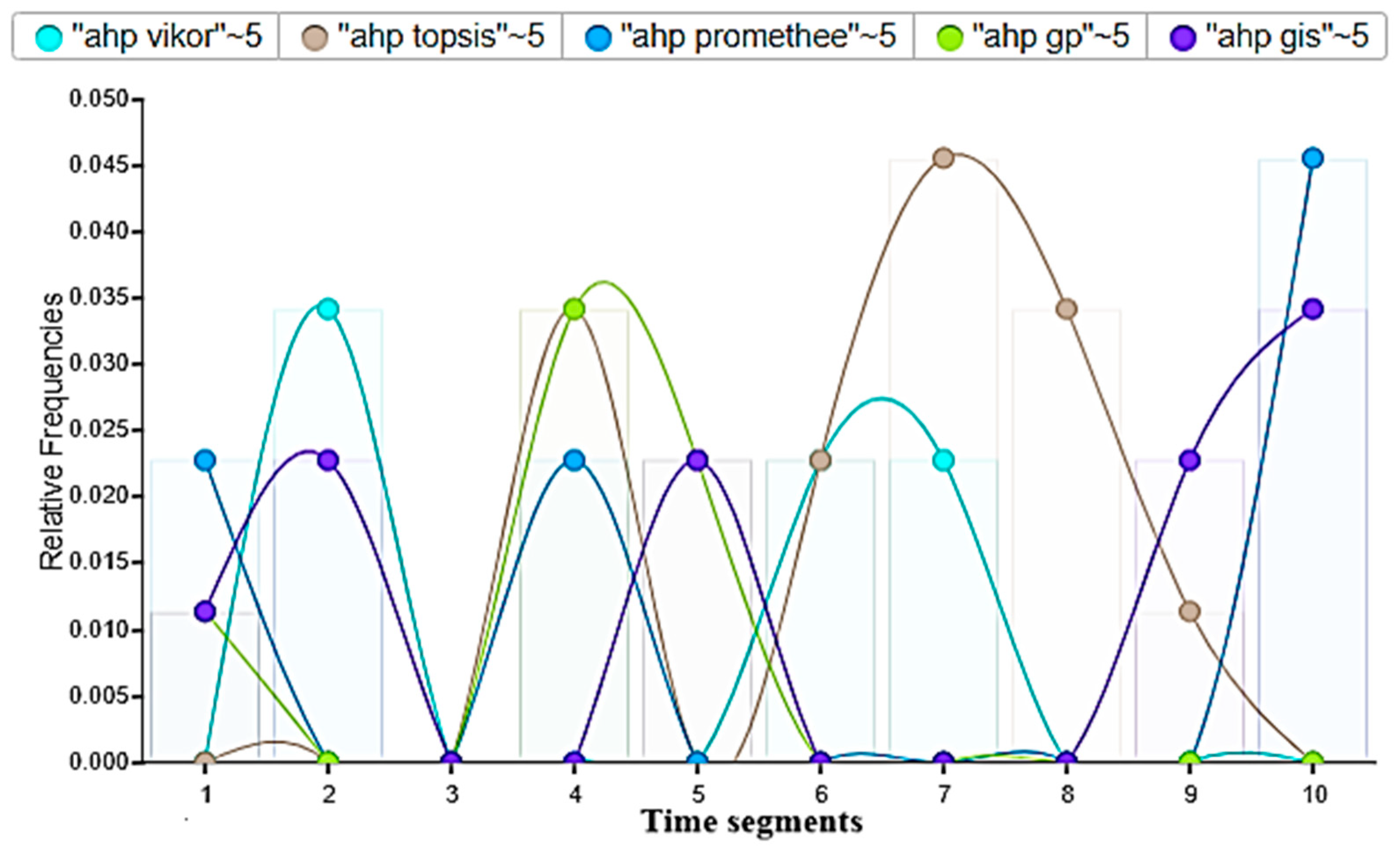
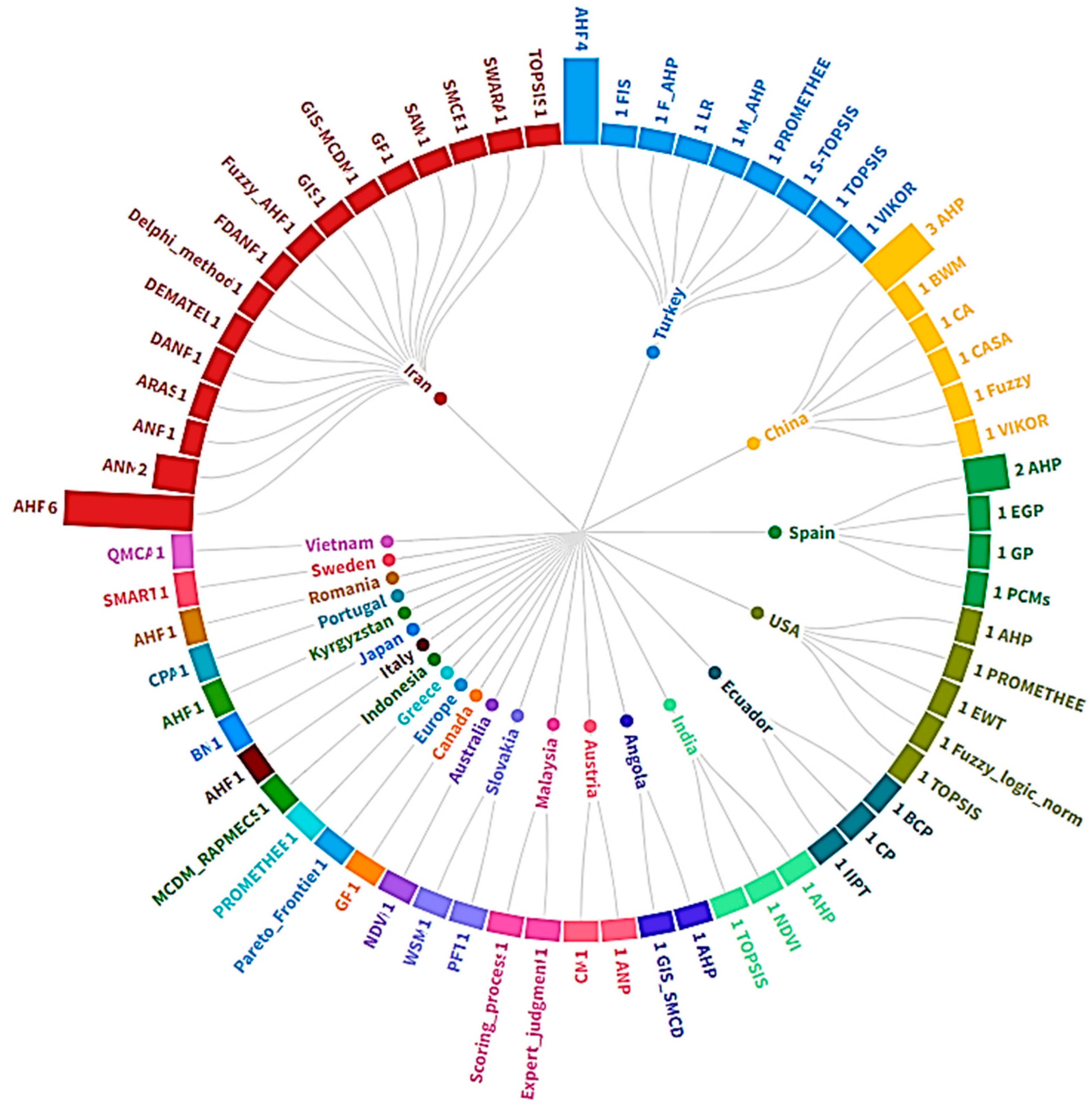
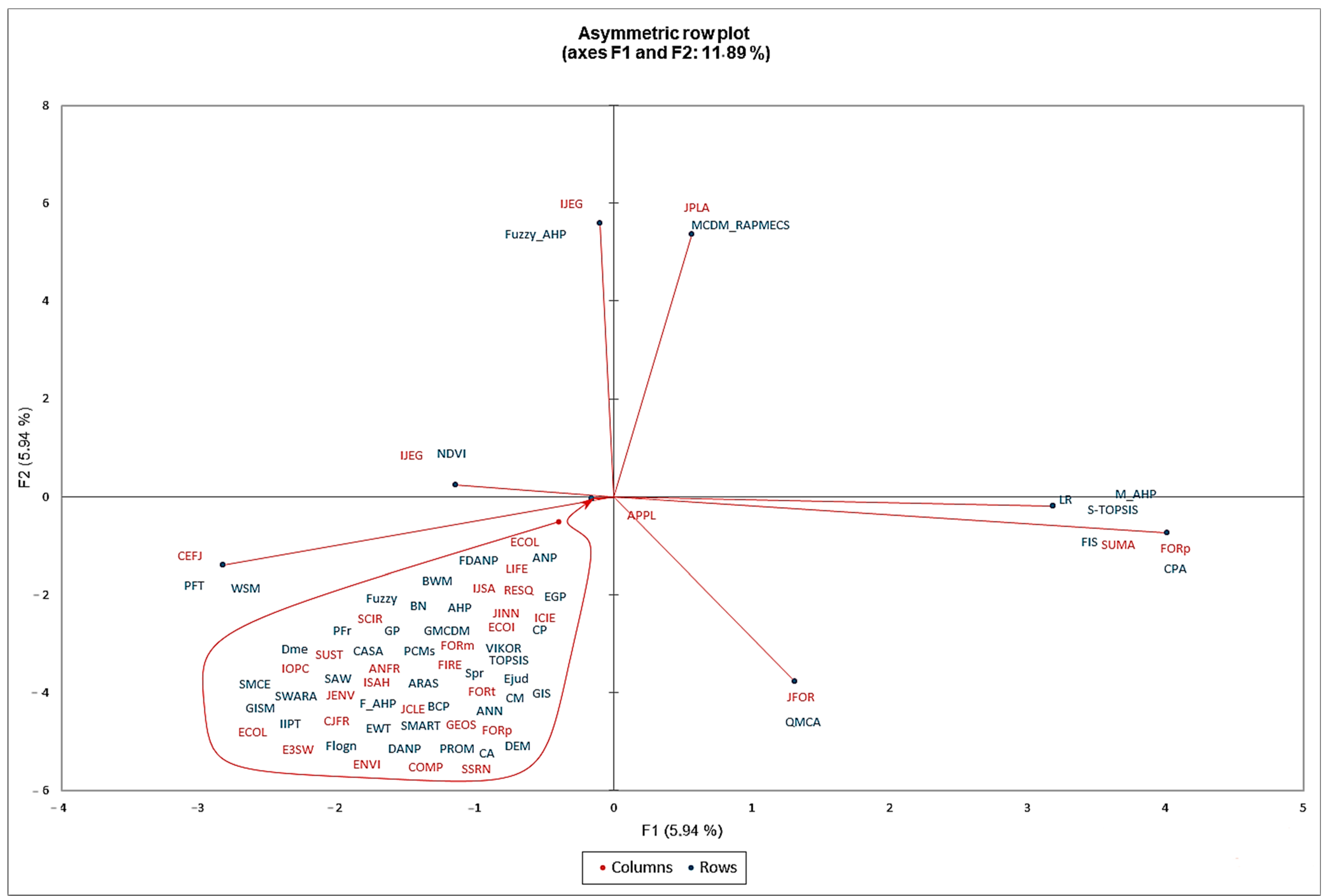
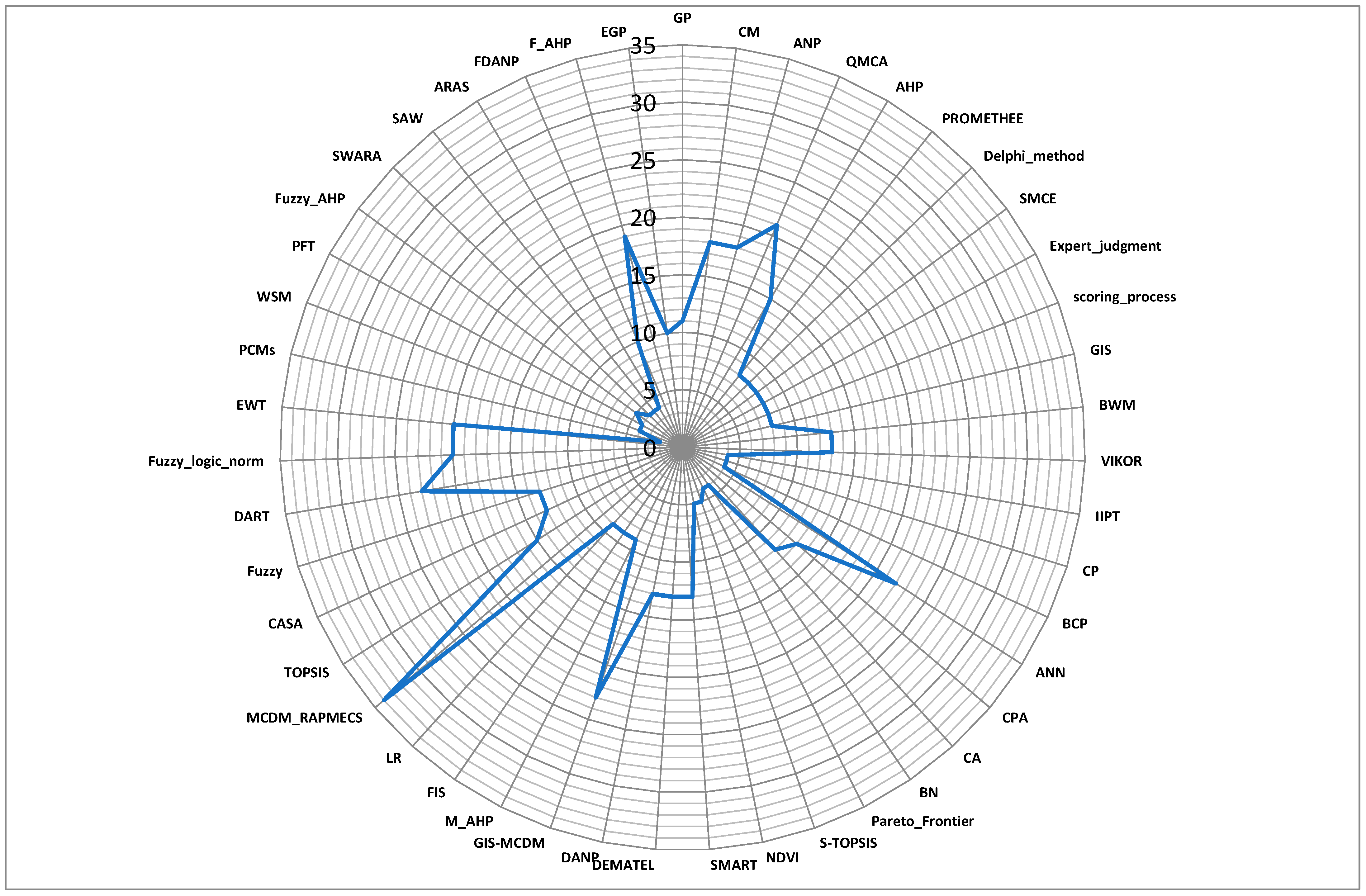
| Key Words | Search String |
|---|---|
| # 1 Multicriteria decision-making | ‘MCDM’ OR ‘Multi-criteria decision-making’ |
| # 2 Methods | ‘method*’ OR ‘approach*’ OR ‘techniqu*’ OR ‘procedure*’ OR ‘strateg*’ OR ‘practice*’ OR ‘methodolog*’ OR ‘model*’ |
| # 3 Forest management | ‘forest* management*’ OR ‘forestr* management*’ OR ‘conservation strateg*’ OR ‘ecosystem management’ OR ‘sustainable utilisation of forest* resource*’ OR ‘argan*’ |
| # 4 Planning | ‘planning’ OR ‘decision support’ OR ‘resource allocation’ OR ‘land use’ |
| # 5 | # 1 AND # 2 AND # 3 AND # 4 |
| Nº | Inclusion Criteria | Exclusion Criteria |
|---|---|---|
| 1 | Text in English and French | Text in languages other than English and French |
| 2 | Article journal (empirical data) | Article review, book, chapters in book, book series, conference Proceeding |
| 3 | Focuses on the forestry sector | Focuses on sectors other than forestry (e.g., agriculture, energy, and transport sectors) |
| 3 | Addresses methods and indicators of MCDM models used in forest management and planning | Do not address methods and indicators of MCDM models |
| 4 | The text includes sufficient detail to carry out data analysis | The text does not provide sufficient detail to carry out data analysis |
| 5 | Empirical or Review of empirical | Non-empirical studies/theoretical and conceptual framework |
| 6 | 2010–2024 | <2010 |
| Directional Measures | ||||||
|---|---|---|---|---|---|---|
| Value | Asymptotic Standardised Error a | Approximate T b | Approximate Significance | |||
| Nominal by nominal | Lambda (λ) | Symmetric | 0.444 | 0.044 | 8057 | 0.000 |
| Models dependent | 0.276 | 0.062 | 4165 | 0.000 | ||
| Journal dependent | 0.588 | 0.061 | 8578 | 0.000 | ||
| Goodman and Kruskal’s tau | Models dependent | 0.388 | 0.013 | 0.930 c | ||
| Journal dependent | 0.603 | 0.003 | 0.275 c | |||
Disclaimer/Publisher’s Note: The statements, opinions and data contained in all publications are solely those of the individual author(s) and contributor(s) and not of MDPI and/or the editor(s). MDPI and/or the editor(s) disclaim responsibility for any injury to people or property resulting from any ideas, methods, instructions or products referred to in the content. |
© 2024 by the authors. Licensee MDPI, Basel, Switzerland. This article is an open access article distributed under the terms and conditions of the Creative Commons Attribution (CC BY) license (https://creativecommons.org/licenses/by/4.0/).
Share and Cite
Kpadé, C.P.; Tamini, L.D.; Pepin, S.; Khasa, D.P.; Abbas, Y.; Lamhamedi, M.S. Evaluating Multi-Criteria Decision-Making Methods for Sustainable Management of Forest Ecosystems: A Systematic Review. Forests 2024, 15, 1728. https://doi.org/10.3390/f15101728
Kpadé CP, Tamini LD, Pepin S, Khasa DP, Abbas Y, Lamhamedi MS. Evaluating Multi-Criteria Decision-Making Methods for Sustainable Management of Forest Ecosystems: A Systematic Review. Forests. 2024; 15(10):1728. https://doi.org/10.3390/f15101728
Chicago/Turabian StyleKpadé, Cokou Patrice, Lota D. Tamini, Steeve Pepin, Damase P. Khasa, Younes Abbas, and Mohammed S. Lamhamedi. 2024. "Evaluating Multi-Criteria Decision-Making Methods for Sustainable Management of Forest Ecosystems: A Systematic Review" Forests 15, no. 10: 1728. https://doi.org/10.3390/f15101728






